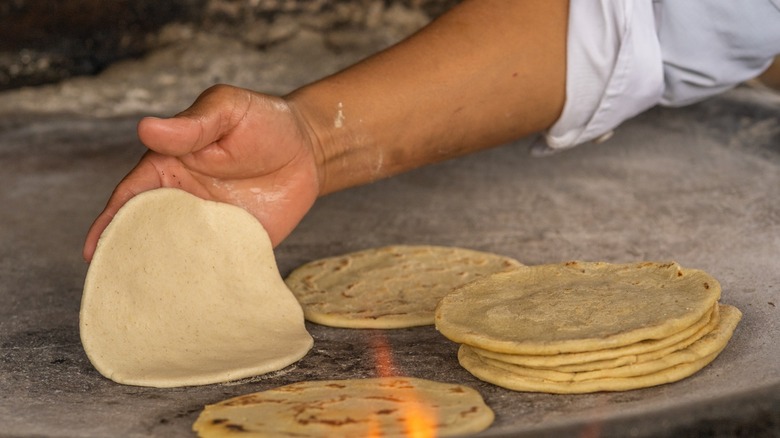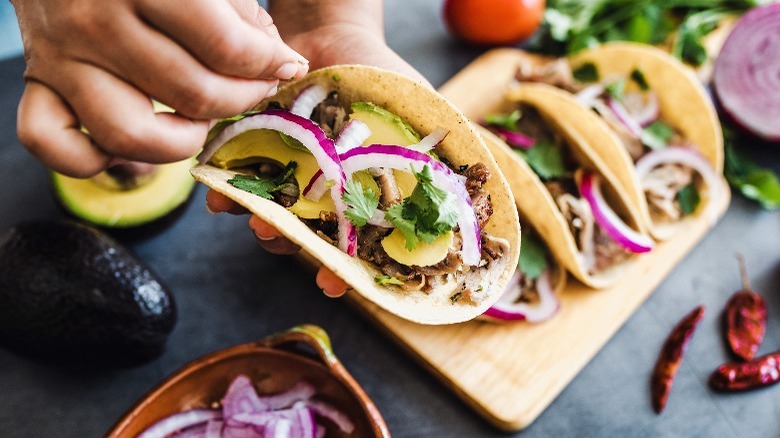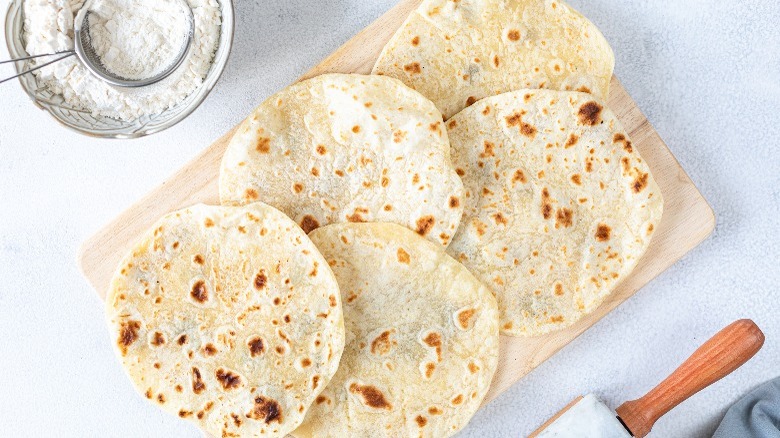Flour Vs Corn Tortillas: Which Do You Use (And When)?
The legacy of the tortilla is immense — and it's not to be confused with the Spanish tortilla. Corn flatbreads have likely served as the lifeblood of Mesoamerican cultures for thousands of years, but the introduction of wheat to Central American cuisine has expanded the field to two main competing types of tortillas. On one side, there's the traditional corn tortilla, which dates back to pre-Columbian times when maize was the staple crop, and on the other side is the more recent flour variation.
Since corn tortillas have a more widespread history, they're quite versatile in their usage. They're the bedrock of the classic taco and a staple of Mexican food and Central American cuisine. On the other hand, flour tortillas are more associated with the arid regions of Northern Mexico and the American Southwest where wheat is more plentiful. Thus, they're better suited for dishes originating from the border area — such as burritos and fajitas — and can hold up better to heavier fillings.
Maize or corn tortillas are extra sturdy
The traditional recipe for corn tortillas consists of soaking kernels in a mixture of limestone ashes and water before draining, milling, and kneading the result into a dough. This process, called "nixtamalization," is still carried out today using both hands and machines, and the ancient limewater is now an alkaline solution of food-grade-calcium hydroxide. The dough is flattened, either by hand or with a tortilla press, and then cooked. The recipe makes for a sturdy, tasty tortilla that can be eaten with filling or enjoyed on its own.
Corn tortillas are the go-to ingredient for tacos and taquitos, and their structure also makes them great for frying into chips and dipping into salsa or guacamole. Enchiladas also work best with corn tortillas since their maize casing mixes nicely with chile sauce, providing a complementary flavor without dissolving into nothingness. In fact, the original street food version of the enchilada was simply a corn tortilla dipped in chile sauce in a manner that doesn't sound too dissimilar to the meat-stuffed tortillas of tacos birria, also with a corn tortilla. Of course, there's nothing wrong with eating a corn tortilla as a side dish, either, and they definitely make the best tostadas thanks to their texture.
Don't flout flour
The softer but larger flour tortilla is more of an invention of the intermingling of modern cultures with a thousand-year-old tradition, and their European legacy has given flour tortillas a reputation for being the stuff of Americans unaccustomed to Mexican culture. The truth is that the cultural hodgepodge of the Mexico-United States border area has created its own cuisine in which flour tortillas often reign supreme. The burrito, the preeminent icon of Cal- and Tex-Mex cuisine, absolutely needs to be wrapped in a flour tortilla since the wrapper's malleable shape makes it ideal for handling heavier fillings that a taco couldn't carry. This is especially true of whoppers like the Mission-style burrito.
The burrito's reported origins are probably due to the ease of transport that flour tortillas provide, like a blanket of bread that can fully cover an entire meal's worth of food. This very convenience has made them the choice of astronauts looking to make crumbless sandwiches in space. Their aptitude to hold up to a good crisping also makes them a solid base for constructing quesadillas. Other types of Mexican-American dishes like fajitas and chimichangas utilize flour tortillas. However, arguably the most creative use of flour tortillas is to swap savory for sweet and turn them into a dessert – think cinnamon sugar tortilla chips.
Tortillas in general offer an incredible array of culinary opportunities, so experimenting with both forms is bound to offer delicious rewards. From traditional corn tacos to wet flour burritos covered in sauce, there really is something for everyone.



